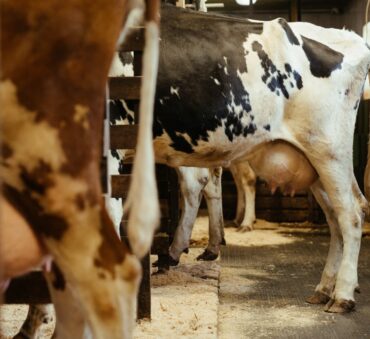The production of biomethane from dairy waste is a process that is gaining momentum across the globe.
But why is this the case?
As we grapple with the challenges of climate change and the need to reduce our carbon footprint, biomethane derived from dairy waste presents a promising opportunity.
The biomethane market is projected to grow by 4.8% CAGR, from $6.08 billion in 2022 to $8.41 billion in 2030.
Let’s explore how biomethane is made from dairy waste, its various applications, benefits, and more.
Key Takeaways
- Biomethane production from dairy waste offers a sustainable and eco-friendly energy source, reducing greenhouse gas emissions.
- Dairy biomethane can be used in various industries like the transportation, agriculture, and electricity sectors.
- By converting dairy manure into biomethane, the dairy industry can improve its waste management, increase cost savings, and have better resource efficiency.
- The USA offers various renewable biofuel incentives, such as the Renewable Fuel Standard and the Investment Tax Credit.
Managing Dairy Manure Waste
Dairy farms meet the world’s growing demand for milk and dairy products. However, with the production of dairy comes the inevitable generation of dairy manure waste.
This waste is challenging to handle in a sustainable way. That’s because traditional disposal methods, such as open lagoons or untreated field application, can result in nutrient runoff, soil contamination, and methane emissions.
So, how can farmers manage dairy waste in a way that prevents environmental pollution?
There are some sustainable practices in manure waste management (like anaerobic digestion) that can convert dairy waste into biomethane.
Because biomethane can be used as a resource, an increasing number of modern dairy farms are converting their manure waste into this valuable biofuel.
Uses of Biomethane
Biomethane is a versatile and eco-friendly energy source.
But what is biomethane used for? Its current applications span various sectors, including:
- Transportation: Biomethane can be used as a cleaner alternative to traditional fossil fuels in the transportation sector. This helps reduce greenhouse gas emissions and air pollution.
- Electricity generation: Biogas can be burned to generate electricity, contributing to the renewable energy mix. It can be used in combined heat and power systems to maximize energy efficiency.
- Heating and cooling: Biomethane can replace natural gas for heating and cooling purposes in homes and businesses while reducing reliance on fossil fuels.
- Injection into gas grids: In some regions, biomethane can be injected into natural gas grids. This “green gas” can then be used for various applications, including cooking and heating.
- Agriculture: Biomethane production on dairy farms can help meet the energy needs of the farm itself, reducing energy costs.
Advantages of Biomethane
Biomethane offers a multitude of advantages for both energy companies and dairy producers. Here are some of the main ones:
Benefits for Energy Companies
For the energy sector, biomethane offers the following benefits:
- Cost-effectiveness: Energy companies can obtain dairy waste at little to no cost. This significantly reduces the raw material expenses associated with biogas production.
- Renewable energy portfolio: Integrating biomethane into their energy portfolio diversifies the sources of renewable energy. This versatility enhances energy companies’ resilience and sustainability, ensuring a stable supply of green energy even in adverse conditions.
- Environmental leadership: Energy companies that invest in biomethane demonstrate environmental leadership within the industry. This can lead to collaborations, incentives, and partnerships with governmental and non-governmental organizations supporting sustainable practices.
Benefits for Dairy Producers
The benefits of biomethane production for dairy producers include:
- Waste management: Dairy producers can efficiently dispose of dairy waste by converting it into biomethane. This not only addresses waste management concerns but also reduces the environmental impact of waste disposal.
- Greenhouse gas reduction: Biomethane production from dairy waste significantly reduces methane emissions, a potent greenhouse gas. This aligns with sustainability goals and helps dairy producers mitigate their environmental footprint.
- Cost savings: By using dairy waste as a resource for biomethane, dairy producers can cut waste disposal costs and potentially generate revenue from the sale of biomethane or electricity produced from it.
- Sustainable reputation: Embracing biomethane technology allows dairy producers to position themselves as environmentally responsible, enhancing their reputation and attracting environmentally conscious consumers.
- Resource efficiency: Dairy waste becomes a valuable resource for energy production, contributing to a circular economy model where waste is transformed into useful products.
- Energy independence: Dairy producers can use the produced biomethane for on-site energy needs, reducing reliance on external energy sources and enhancing energy security.
Disadvantages of Biomethane
While biomethane offers numerous advantages, there are also some disadvantages like:
- High initial costs: Establishing biomethane production facilities can be costly. The equipment and infrastructure needed for anaerobic digestion and gas upgrading can require significant upfront investments.
- Energy intensity: The process of producing biomethane consumes energy, primarily for heating during anaerobic digestion and gas purification. This energy demand may partly offset the environmental benefits.
- Methane leakage: Biomethane is primarily composed of methane, a potent greenhouse gas. Methane leakage during production, transportation, or utilization can contribute to climate change if not properly managed.
- Market and regulatory uncertainty: Biomethane markets can be less mature than those for fossil fuels, leading to price volatility and uncertainty for producers. Regulatory frameworks may also affect the economic viability of biomethane projects.
- Competition for feedstock: As demand for biomethane increases, competition for organic feedstock sources, such as dairy waste, may intensify. This could impact feedstock availability and costs.
- Environmental concerns: While biomethane reduces methane emissions from waste, concerns about land use for energy crops or potential pollution from digestate (a byproduct of anaerobic digestion) can arise.
But how is biomethane made? Next, let’s debunk the biomethanation process.

Biomethanation Process
Biomethanation is a natural biological process that harnesses the power of microorganisms to convert organic matter (in this case, dairy waste) into valuable biomethane gas.
This sustainable and eco-friendly process involves four stages, including:
Hydrolysis
During hydrolysis, the complex organic compounds (such as carbohydrates and proteins) are broken down into simpler soluble compounds. Enzymes secreted by hydrolytic bacteria play a crucial role in this process, converting large molecules into smaller, more accessible forms.
Acidogenesis
During acidogenesis, the products from hydrolysis are further broken down into organic acids and alcohols.
Acidogenic bacteria are the primary drivers of this stage. They continue the decomposition process, generating intermediary products for the subsequent phases.
Acetogenesis
In the acetogenesis stage, the organic acids are converted into:
- Acetic acid
- Carbon dioxide
- Hydrogen
This conversion is facilitated by acetogenic bacteria, which thrive in anaerobic conditions and contribute to the gradual transformation of organic matter.
Methanogenesis
The final stage involves the conversion of acetic acid, carbon dioxide, and hydrogen into biomethane gas.
Methanogenic archaea are responsible for this critical step. They produce methane, which can be captured and utilized as a clean, renewable energy source.
Methods of Upgrading Dairy Biogas to Biomethane
The journey from dairy biogas to biomethane involves various methods and technologies to enhance its quality and energy potential. These include:
Upgrading Biogas to Biomethane Using Carbon Dioxide Removal Technologies
One of the most conventional methods to enhance biogas purity and turn it into valuable biomethane is by using CO2 removal technologies.
This process employs various techniques, such as:
- Pressure swing adsorption: In PSA, biogas is exposed to a specialized adsorbent material under different pressure levels, allowing it to selectively capture CO2 while allowing methane to pass through. This results in a biogas stream with significantly reduced CO2 content.
- Amine scrubbing: Similarly, amine scrubbing uses chemical reactions to absorb CO2, effectively cleaning the biogas.
Upgrading Biogas to Biomethane Using Carbon Dioxide Utilization Technologies
Instead of merely removing CO2 from biogas, CO2 utilization harnesses the captured CO2 for further use.
For example, microorganisms can be employed to convert CO2 into methane, thereby increasing the biomethane yield.
Chemical conversion processes also play a role, where CO2 is transformed into methane or other useful chemicals, turning a potential waste product into a resource.
New Technologies in Carbon Dioxide Conversion
Carbon dioxide conversion technologies are focused on maximizing the utilization of CO2 while reducing emissions.
Innovative catalysts and processes can efficiently convert CO2 into methane, improving both the environmental and economic aspects of biomethane production.
These cutting-edge technologies are at the forefront of sustainable energy production, helping to reshape the future of the biogas and biomethane industries.
Environmental Implications of Biomethane Production from Dairy Waste
Production of biomethane from dairy waste holds significant promise in reducing the environmental footprint of the dairy industry. For example, it:
- Reduces CO2 emissions: The dairy industry is a notable contributor to greenhouse gas emissions, primarily due to the methane released from decomposing manure. Biomethane production from dairy waste directly addresses this issue. By capturing and converting methane into biomethane, we can substantially cut down methane emissions.
- Can be used as a sustainable fuel: Biomethane’s potential as a sustainable fuel source means it can be used in various applications, such as transportation and energy generation, reducing our reliance on fossil fuels. As a renewable energy resource, biomethane contributes to a cleaner energy mix, offering a path towards more sustainable practices.
Renewable Biofuel Incentives in the USA
The United States has been actively promoting the production and use of renewable biofuels through a series of incentives and policies. These include:
- Renewable Fuel Standard: The RFS program, administered by the Environmental Protection Agency, mandates that transportation fuel sold in the United States contains a certain volume of renewable fuels, including biomethane. This program not only reduces greenhouse gas emissions but also spurs investment in advanced biofuel technologies.
- Federal tax credits: Various federal tax incentives encourage the production and use of biofuels. For instance, the Biofuel Producer Credit provides a tax credit for producers of qualified biofuels, while the Alternative Fuel Credit supports the use of alternative fuels in transportation.
- Investment tax credits: The ITC program offers tax credits for investments in renewable energy systems. These credits help offset the initial capital costs of constructing biomethane production facilities.
- USDA Programs: The United States Department of Agriculture offers grant and loan programs to support the development of bioenergy projects, including those focused on dairy waste-to-biomethane initiatives.
Conclusion
Converting dairy waste into biomethane is a sustainable solution that reduces greenhouse gas emissions and provides a renewable energy source.
But how can more dairy farms start repurpose their waste?
At Shapiro, we understand the importance of responsible dairy waste management. With our nationwide network of qualified partners and industry expertise, we are committed to helping you manage your organic waste responsibly.
Ready to embrace a more sustainable future? Contact us today and find out how we can help you.
Biomethane from Dairy Waste FAQs
Biomethane primarily consists of methane (CH4), just like natural gas. However, it also contains small amounts of other gases, such as carbon dioxide (CO2) and traces of impurities like hydrogen sulfide (H2S).
Biomethane is often considered an upgraded form of biogas.
While biogas is the raw gas produced during anaerobic digestion, biomethane is purified to remove impurities, especially CO2, resulting in a gas that is almost pure methane.
This purification process makes biomethane comparable in quality to natural gas and suitable for injection into the natural gas grid or use as vehicle fuel.
The cost of biomethane production can vary depending on several factors, including the feedstock used, production technology, and scale.
In some cases, biomethane production can be competitive with natural gas, especially when produced at a large scale.
Biomethane is considered better than conventional methane as it is a renewable and sustainable source of methane. This makes it a greener alternative to fossil-derived methane, which can be used in various applications like energy production and transportation fuel.
Baily Ramsey, an accomplished marketing specialist, brings a unique blend of anthropological insight and marketing finesse to the digital landscape. Specializing in educational content creation, she creates content for various industries, with a particular interest in environmental initiatives.



